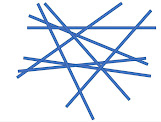Proved that mean pore diameter of nonwoven fabric dp is independent of fibre diameter d and dependent on fibre length l.
 |
| Fig: randomly oriented fibres |
P(n) = e-c * cn/n! , where c is total projected area fibres per unit area of the plane (total coverage).
Evendently, c=nld,
where l= fibre lingth
and d=fibre width (diameter)
The fraction of area covered by one fibre is:
P(0) = e-c = ξ -----------(i)
Clearly, (1-ξ ) is the fraction of the unit area covered by fibres.
The total area Ac occupied by all fibres croosing per unit area of the plane is:
Ac = ∑n=2n→∝(n-1)P(n)
= ∑n=2n→∝(n-1)e-c * cn/n!
= e-c[c2/2! + 2c3/3! + ... + (n-1)*cn/n! + ...]
= e-c[c0/0! + c1/1! + 2c2/2! + ... + ncn/n! + ... - (c0/0! + c1/1! + ... + cn/n! + ...)]
= e-c[c0/0! + (c1/1! + c2/1! + ... + cn/(n-1)! + ...) - (c0/0! + c1/1! + ... + cn/n! + ...)]
= e-c[c0/0! + c(c0/1! + c1/1! + ... + cn-1/(n-1)! + ...) - (c0/0! + c1/1! + ... + cn/n! + ...)]
= e-c[1 + cec - ec]
= e-c + c - 1
= c - (1 - ξ) (using equation i)
thus, the total area of fibre crossing Ac is difference between the total coverage c and fraction of the unit area covered by fibres (1 - ξ).
 |
| Fig: area of one fibre |
ac = (π⁄2 d) * d = π⁄2 d2 = π⁄2 d2 -----------(i)
= (e-c + c - 1)/Πd2/2
= 2(e-c + c - 1)/Πd2
= 2/Πd2[(c0/0! - c1/1! + c2/2! - ...) + c1/1! - c0/0!]
= 2/Πd2[c2/2! + c3/3! + ...]
≅ 2/Πd2 * c2/2!
= c2/Πd2
= (nld)2/Πd2
= (nl)2/Π -----------(ii)
mean cross-sectional area of pore is:
ap = ξ/(nc-n)-e-c
= 1/nc-n
= 1/nc(1-n/nc)
≅ 1/nc
= π /(nl)2 -----------(iii) (using equation ii)
we consider the mean cross-sectional area of pore is equal to area of a circle of diameter dp ,then
ap = Πdp2⁄4 = π⁄(nl)2
 |
| Fig: pore diameter |
=> dp2 = 4⁄(nl)2
=> dp = 2⁄nl
Hence, it is proved that mean pore diameter of nonwoven fabric dp is independent of fibre diameter d and dependent on fibre length l.

Comments